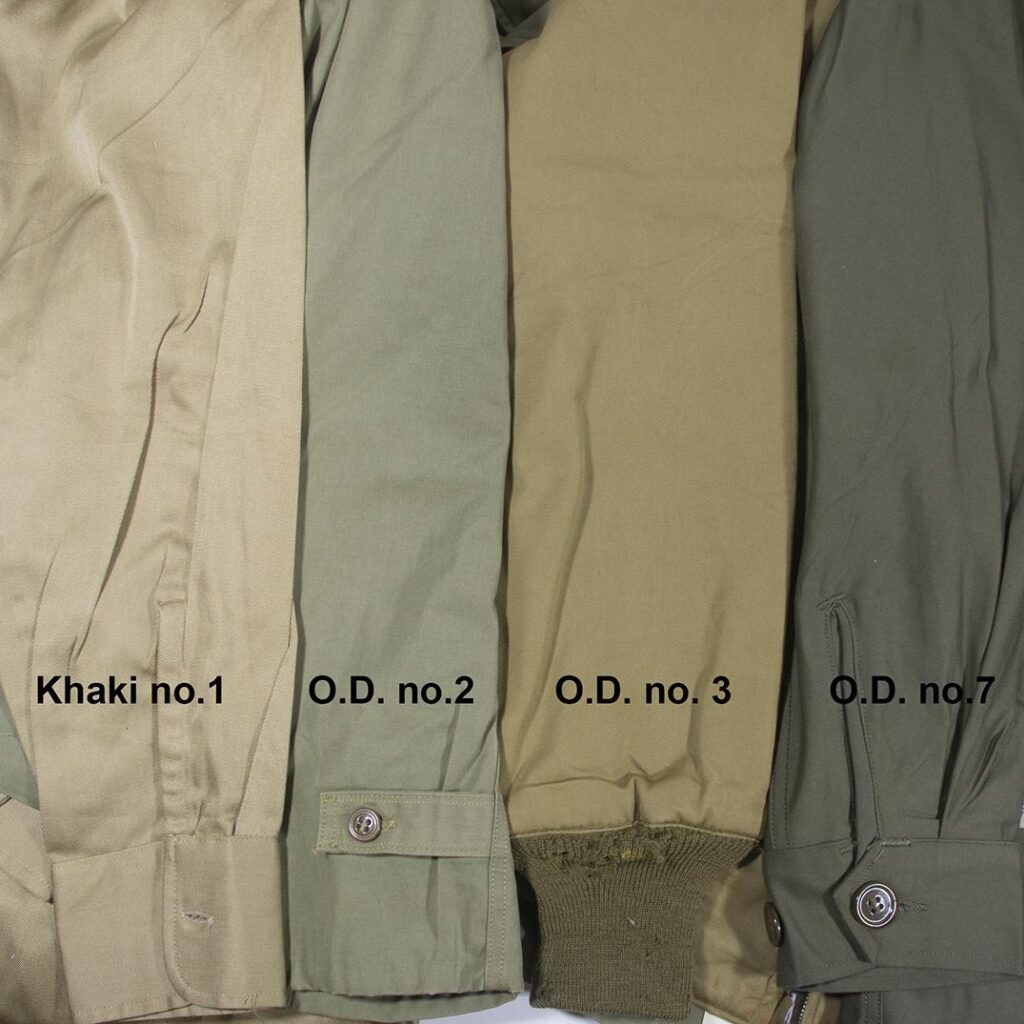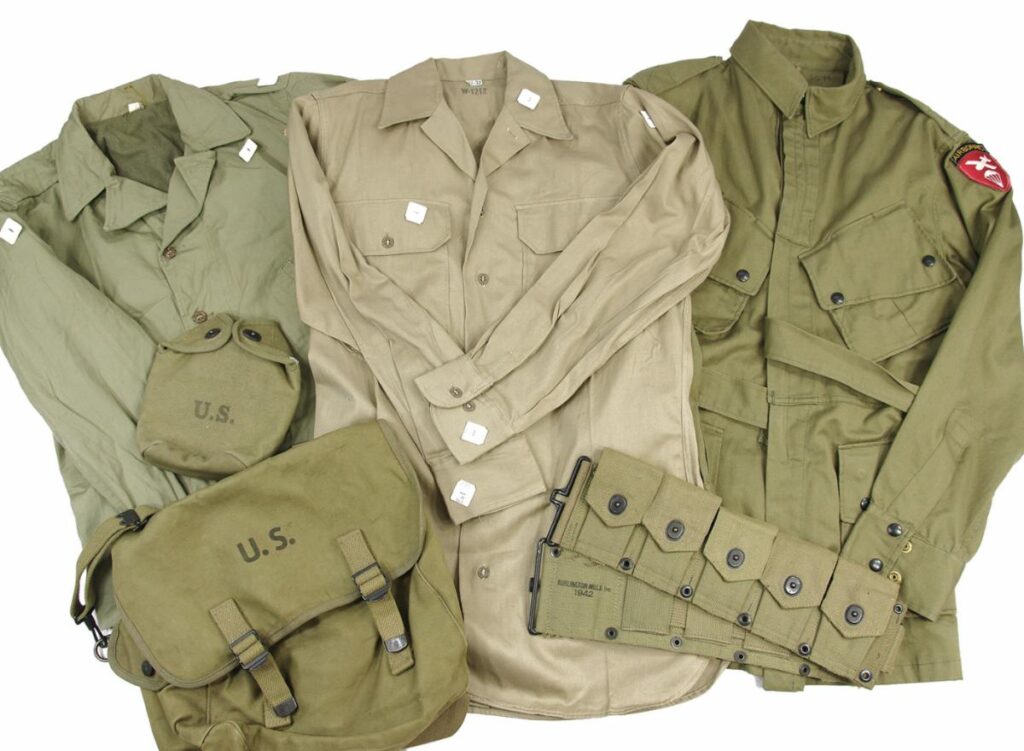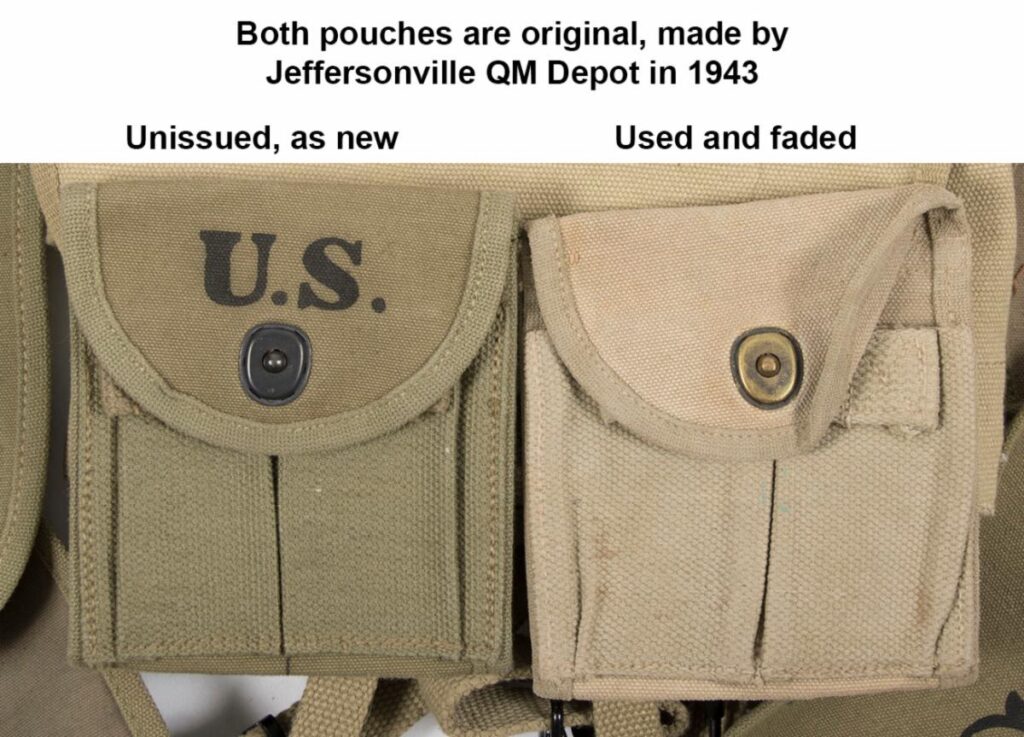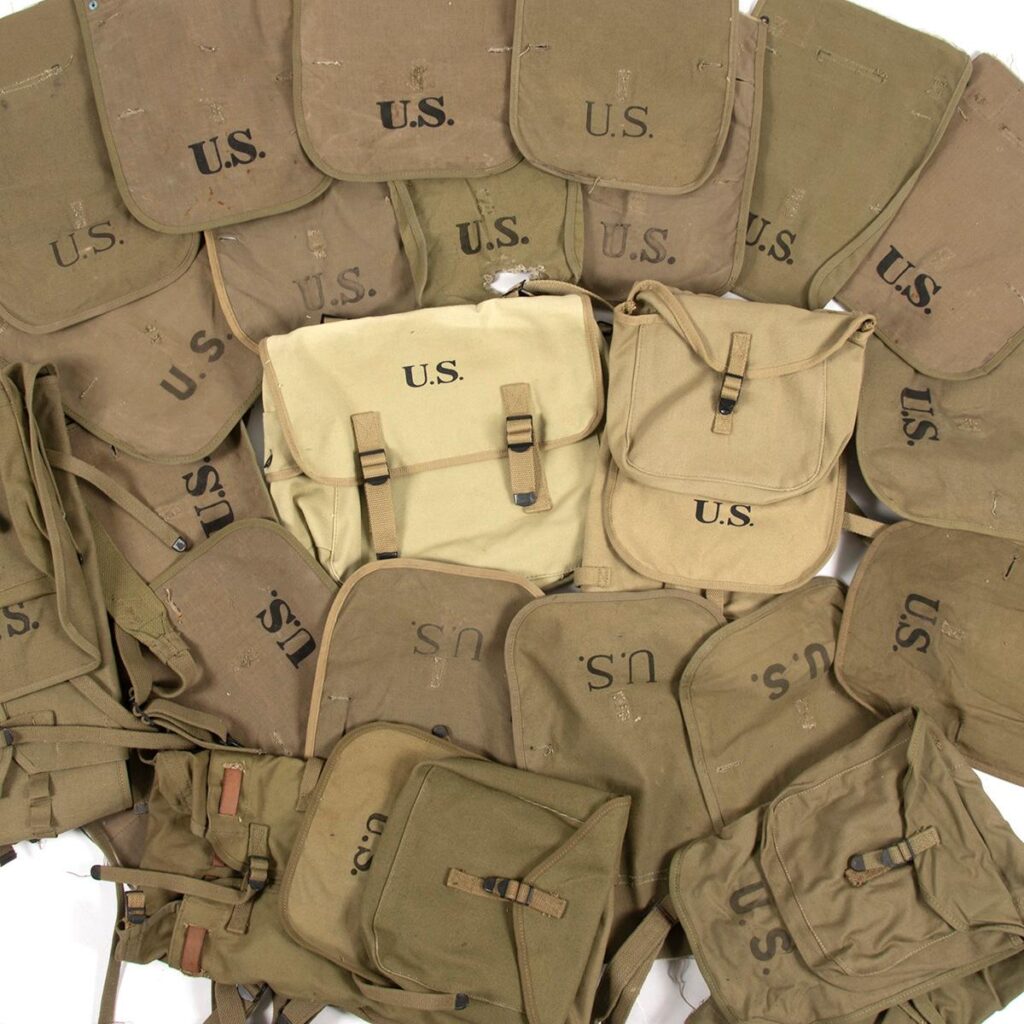 Original US uniforms in new or nearly new condition with the US Army’s terms for each color.
Original US uniforms in new or nearly new condition with the US Army’s terms for each color.
L to R: Summer Service Shirt, M41 Jacket, Tanker Jacket, M1943 Field Jacket
Khaki Fever
Although the pestilence seems to have mutated into somewhat less virulent strains in recent years, it remains endemic to the hobby of WWII (and WWI) collecting/ reenacting. Precisely how and why it took hold decades ago is unknown- various theories exist but none can be confirmed.
Regardless, it is perhaps the single biggest misconception (headache) in this business. This post was just as valid in 1997, 2006, 2012, as it is today. I’m sure it’ll be so in 2032 as well.
Now what am I ranting about? Among many enthusiasts, there is a quasi religious belief that US WWII uniforms and equipment were made from beige colored fabrics. Nearly every day for 25+ years, we receive calls and emails questioning (or complaining) whether our US jackets, shirts, trousers, cartridge belts, packs, bags and whatnot are the correct color. They must be KHAKI! (beige)
When we have actual khakis (Summer Service Uniforms), despite having the largest and highest resolution photos in this market, we get drowned with calls asking if they are “khaki like in the photos”. It sounds like a joke but it’s not. No…we photoshopped over the purple polka dots…
Poor Gina has suffered through countless expert lectures about khaki. A few blue ribbon winners even fuss that our HBT’s, Helmets and, at least one, that our boots weren’t khaki. A couple have howled because their fieldgear wasn’t a perfect match for their jump uniform. It’s like a Monty Python skit. I can look at Gina and just say “khaki” and she throws pens at me.
This misconception continues despite originals being plentiful and their color(s) clearly being at odds with the gospel of the khaki cult. A reasonable person might think that these facts should act as a cure or vaccine, but the disease rages on. Over the years, I’ve come to consider this is a genderesque situation where truth is unimportant and contradicting a fantasy is a crime.
So let’s get Khakiphobic.
Historical Facts
During WWII, the only American Army uniforms that were actually khaki in color were the Summer Service Uniforms- commonly referred to as “khakis”. How shocking. Aside from khakis, all field uniforms and field equipment were one of several shades of olive drab, henceforth “o.d.”. The term o.d. was used both in official correspondence and documentation as well as by the soldiers. In our world, the best medicine is visual proof.
 Originals- nothing is khaki except…Khakis!
Originals- nothing is khaki except…Khakis!
Only the shirt is khaki
The most incessant complaints are for khaki jump uniforms, M41 jackets, musette bags and cartridge belts. Above are original items, all in mint condition, next to an original khaki shirt. Guess what…they ain’t khaki. All but the M41 were OD3 which, in most cases, equates to an olive-tan.
News Flash- M41 Jackets are even greener: To add insult to injury, original M41 Field Jackets were made from OD2 colored poplin. This tends to be range from a grayish tan to a grass stain green when new. (Emphasis on the last two words.)
If originals aren’t khaki, why does half the internet insist they are? My suspicion is twofold.
First, simple semantics. Most collectors differentiate OD3 from OD7 items by referring to them as “khaki” or “O.D.”. They realize khaki does not necessarily equate to the color of Docker’s, and that a khaki shirt or garrison cap is lighter than a tanker jacket or a Haversack. However, neophyte enthusiasts come into the picture and they take the term “khaki” literally. Throw in gamers and cosplayers and one has a mess.
Second, dyeing was imperfect in 1942. Much of the items worn by our troops faded, some of it relatively quickly so much so that it was one of the top complaints about the early HBT’s and M41 Jackets in general. Heavily faded OD2 and OD3 things do look beige- but they didn’t look that way when new. And new is the look we are striving for in our products.
The photo below shows the fading problem clearly- both pouches are made in the same year by the same manufacturer.

The infection has spread
Some years ago, we carried a less expensive line of US gear from a surplus company from Chicago. For a year or two it looked good and was a near perfect OD3 color- just like originals. Then a beige shipment arrived. I called them to ask wtf. They told me they were tired of all the returns from the khaki weenies howling that they didn’t want green chit. It must be KHAKI!
Now, it appears that most other manufacturers of US gear have bowed to the khaki mob and now make everything in stunning and brave beige.
At least one offers khaki AND “od3”.
Gag.

Two of the most plentiful & popular (cheap) reproductions on the market surrounded by every original Haversack I could scrounge. The difference is oh so subtle…
It’s amazing how stunning beige lights up the forest as the troops march by, alerting even the most myopic and hungover of Wehrmacht snipers lurking in their plywood bunkers. Yes, besides being totally wrong, it’s almost as attention grabbing as hunter orange.
When it fades a little it will be basically white. Of all colors! Awful.
Apparently the fever hit the beaches too.
In recent years the mania has spread to German gear as well. The demands for khaki (or golden) breadbags, packs, and A-frames have increased dramatically- maybe thanks to TikTok videos posted by expert historians. Yes, the Germans had a smattering of khaki-ish items, but most of those were more a mustard tan in color, with the bulk of their canvas gear being a shade of olive or fieldgray.
I’ve resigned myself to the idea that there is no cure. I’ll give a big nod to social media where many have valiantly fought the fever with me, but regular outbreaks still occur as new enthusiasts continue to drink the Khaki Koolaid from where ever it flows. For our part, it’s exasperating but we will never give in. We’ll only make it khaki if that’s the color it was in WWII.
